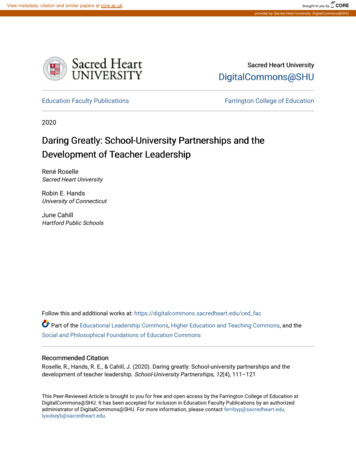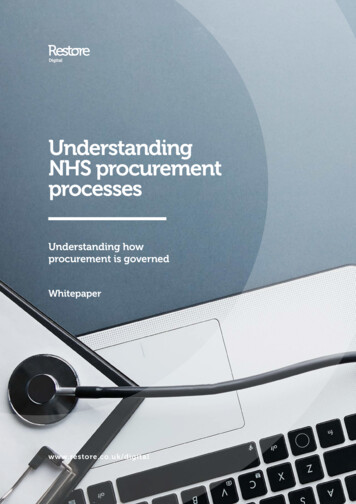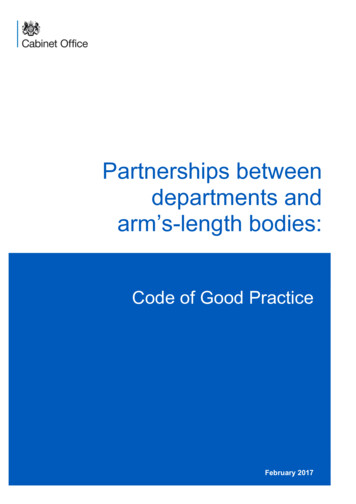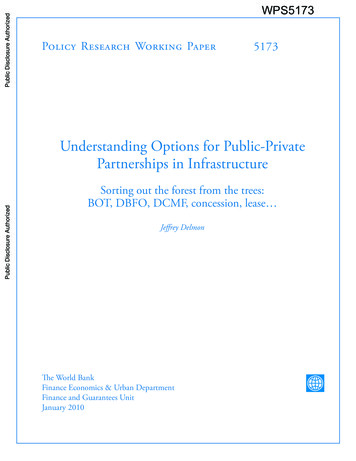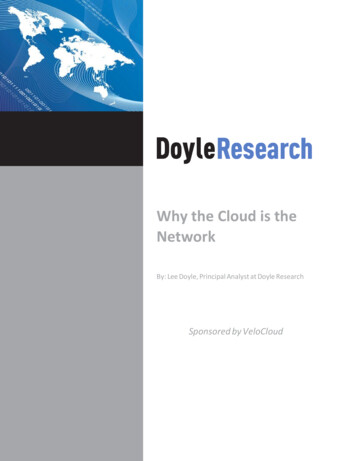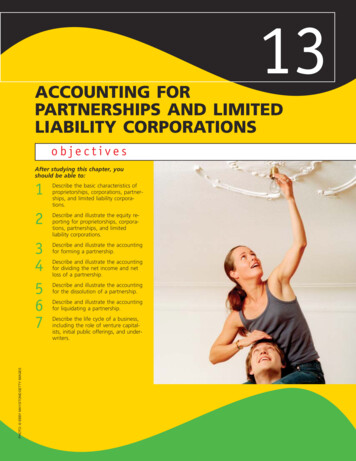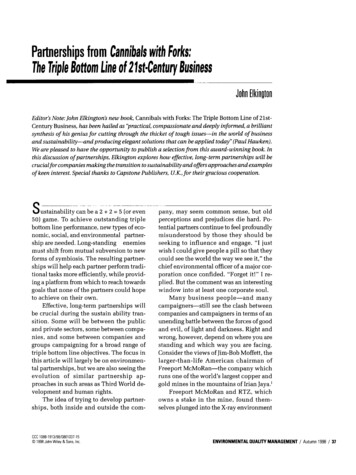
Transcription
Partnerships from Cannibals with Forks:The Triple iottom line of 2 1st CenturyBusinessJohn ElkinjtonEditor’sNote: John Elkington’s new book, Cannibals with Forks: The Triple Bottom Line of 21stCentury Business, has been hailed as “practical,compassionate and deeply informed, a brilliantsynthesis of his genius for cutting through the thicket of tough issues-in the world of businessand sustainability-and producing elegant solutions that can be applied today”(Paul Hawken).We are pleased to have the opportunity to publish a selection from this award-winning book. Inthis discussion of partnerships, Elkington explores how effective, long-term partnerships will becrucialfor companies making the transition to sustainability and offers approaches and examplesof keen interest. Special thanks to Capstone Publishers, U.K.,for their gracious cooperation.- .Sustainability can be a 2 2 5 (or even50) game. To achieve outstanding triplebottom line performance, new types of economic, social, and environmental partnership are needed. Long-standing enemiesmust shift from mutual subversion to newforms of symbiosis. The resulting partnerships will help each partner perform traditional tasks more efficiently, while providing a platform from which to reach towardsgoals that none of the partners could hopeto achieve on their own.Effective, long-term partnerships willbe crucial during the sustain ability transition. Some will be between the publicand private sectors, some between companies, and some between companies andgroups campaigning for a broad range oftriple bottom line objectives. The focus inthis article will largely be on environmental partnerships, but we are also seeing theevolution of similar partnership approaches in such areas as Third World development and human rights.The idea of trying to develop partnerships, both inside and outside the com-CCC 1088-1913/98/0801037-150 1998 John Wiley & Sons, Inc.pany, may seem common sense, but oldperceptions and prejudices die hard. Potential partners continue to feel profoundlymisunderstood by those they should beseeking to influence and engage. “I justwish I could give people a pill so that theycould see the world the way we see it,” thechief environmental officer of a major corporation once confided. “Forget it!” I replied. But the comment was an interestingwindow into at least one corporate soul.Many business people-and manycampaigners-still see the clash betweencompanies and campaigners in terms of anunending battle between the forces of goodand evil, of light and darkness. Right andwrong, however, depend on where you arestanding and which way you are facing.Consider the views of Jim-Bob Moffett, thelarger-than-life American chairman ofFreeport McMoRan-the company whichruns one of the world’s largest copper andgold mines in the mountains of Irian Jaya.’Freeport McMoRan and RTZ, whichowns a stake in the mine, found themselves plunged into the X-ray environmentENVIRONMENTALQUALITYMANAGEMENT / Autumn 1998 / 37
I1Revolution5.FocusOld paradigm)New paradigmPartnershipsSubversion)Symbiosis.when a group of hostages were seized bymembers of the Free Papua Movement(OPM), as part of its independencestruggle. The OPM see the mine, operatedvirtually as an extra-territorial part ofAmerica with the protection of the Indonesian military, as a symbol of the problemsthey face. Worse, the local tribespeoplein addition to having been driven off theirlands-complain that run-off from themine is polluting rivers and that the removal of forest cover is affecting the localclimate. Paradoxically, the hostages included students from Cambridge University who had been working with localtribes to learn how they exploited naturewithout destroying it.The Freeport McMoRan response toenvironmental challenges can only be described as robust. The scale of the pollution, Jim-Bob Moffett retorted, “is equivalent to me pissing in the Arafura Sea.” Hetold The Times that he was involved in “anew Cold War” with local and international campaigners. “This,” he said, “is nota job for us, it’s a religion.” All of whichtends to make negotiation with the enemy,let alone the development of longer termpartnerships, inconceivable.MONKEY TRAPSSuch reactions bring to mind the old“Monkey Trap” tale (Exhibit 1).Companieslike Freeport McMoRan would do well tolearn and understand it. The history of theenvironmental revolution is full of examples of companies locking themselvesinto various forms of monkey trap. In thecase of Freeport McMoRan and RTZ, theircorporate fists are locked in the earth bythe thought of the billion tonnes of copperand gold ore to be won as giant mechanical shovels chew away at the mountaintops. And the nature of human beings and38 / Autumn 1998 / ENVIRONMENTAL [IUAUTY MANAGEMENTof corporations being what it is, the 21stcentury will also produce abundant examples of the corporate monkey trap inaction. Some companies will escapeempty-handed, some will work out ways ofbreaking the jar out of the earth, but morethan a few will also be hammered senselessby their opponents.WHY WORRY?: TOMORROWS CEOS AREGREENAnother reason for business to worryis that the environmental agenda is way upthe list of priorities ofthe emerging generations of university graduates. “Europe’sgraduates put care for the environment topof their agendas,” according to The Europ e a n Graduate Survey, which covered16,000 final-year students in 56 universities, business, and engineering schoolsacross 14 countries3But, while 68 percentsaid they were prepared to pay the price ofa better environment, only 38 percentthought that the global picture would improve. These young people are also switching on to the Internet in a big way: 61 percent used it in this latest survey, comparedwith just 37 percent ii year earlier.For these, and many other, reasons, itis clear that we now stand on the threshold of a new era in the relationships between business and its many stakeholders,including potential new recruits. We alsosee, in the words of a recent book on greenactivism in America, environmentalism atthe cros roads. Faced with growing mediaskepticism and a degree of political backlash, environmentalists have been rethinking what they do and how they do it.For business, the value of the multipleperspectives introduced by stakeholderdialogue processes has been demonstratedtime and again for companies. The priorities and strategies emerging from such pro-John Elkington
Exhibit 1. The Monkey TrapI,A monkey comes into a village at night. He finds a hole in the ground and circles it warily, smelling food. His paw justbarely fits into the opening, because the hole is actually a narrow-mouthed jug buried flush with the ground. Hemanages to scoop up a handful of rice, but can‘t run off with the food-since his closed fist can’t be drawn backthrough the jar’s opening. Not wanting to lose the food, he screeches, but keeps his fist closed. Shortly, a villagercomes by with a rock or pole and kills the monkey, either as a pest or for food.*. .cesses turn out to be better-rooted inemerging realities, more credible with allstakeholders, and, as a result, more robust.Not that this approach has been troublefree: some of the information released byNovo Nordisk to visiting stakeholdersturned up as part of a consumer campaignagainst the company’s enzymes in Germany, Austria, and Switzerland. But that,the company believes, is part of the priceyou pay to build the relationships whichare likely to be indispensable during thesustainability transition.There is no question that these changespotentially represent a ‘‘lox”challenge forenvironmentalists and the traditional styleof relationship they have developed withbusiness. But it is still far from clear howmany of today’s campaigning organizations will successfully make the transitionto the new ways of operating. Equally, thechanging conditions will create opportunities for totally new forms of campaigning,pressure politics, and partnerships betweencampaigners and like-minded corporations.Indeed, these initiatives may well be developed from scratch by some of the studentscovered in the European’s survey.Meanwhile, earlier generations ofgreen activists are moving into the mainstream. Take German politician JoschkaFischer, who at the time of this writing wasleader of the Bundestag Greens. BecauseFischer is determined that the Greens willinfluence national, not just ecological,policy, he gave himself a crash course ineconomics and began to speak out positively on foreign policy issues like sendingtroops to Bosnia and European MonetaryUnion. His aim is to lead the Greens into aleft-center coalition “with an independentI!IIpersonality and high economic competence.” He may or may not succeed butjokes that, “I stand on my head day andnight figuring out how I can become Chancellor.”5 Given enough time and the rightbreaks, some of these people will play keyroles in the sustainability transition. Expect to see growing numbers of them popping up on company boards before long.As we shift towards the sustainablebusiness paradigm, we will see companieslike Freeport McMoRan and RTZ trying todevelop strategic partnerships with individual campaigners and with major campaigning groups. Some will succeed inattracting powerful partners, some not. Butthe terms and conditions of these partnerships will have changed profoundly. In theold order, very few campaigning groups, ornongovernmental organizations (NGOs) asthey are better known, were prepared towork directly with industry. Some neverwill, but longer term they will probably turnout to be in the minority. What is differenttoday, however, is that the NGOs are increasingly in a position of power-and some arepreparing to use it in novel ways, workingwith business and through markets.Faced with growingmedia skepticismand a degree ofpolitical backlesh,environmentalistshave been rethinkingwhat they do andhow they do it.TRAPPING NGO FISTSIn the old order, the NGOs that decidedto work with business generally wantedmoney and were considered to be selloutsby radical activists. Whether the fundingwas for core costs, campaigns, or other initiatives, the relationship was simple.Crudely stated, it was “Give us money andwe will splash your name over some appropriate surface.” A few leading NGOs,particularly those dedicated to wildlifeconservation, developed huge corporatePartnerships from Cannibals with Forks: The Triple Bottom fine of2lst-Century BusinessENVIRONMENTALQUALITY MANAGEMENT / Autumn 1998 / 39
One pioneer hasbeen the U.S.EnvironmentalDefense Fund (EDF),which has workedwith companies asdiverse asMcDonalds andGeneral Motors.sponsorship departments dedicated solelyto hunting down deep-pocketed corporatedonors. And, like the monkey with its fistin the trap, they too then tended to findthat they were in no position to run effective campaigns against their newfoundfunding partners. Some companies evenoffered funding with the explicit aim oflocking up potential enemies, or even ofusing them as Trojan horses.In any event, the conditions in whichsuch partnerships were pursued changeddramatically when two things happened inparallel. First, companies, inevitably, became more discriminating. They began toinsist on a bigger PR bang for their sponsorship buck. And they wanted their benefits in the form of an enhanced reputationwith selected audiences. As “cause-relatedmarketing” evolved, some of those NGOcorporate sponsorship departments became almost indistinguishable from mainstream advertising or PR agencies.The second shift was driven by NGOneeds. They found themselves managingincreasingly large projects and budgets.Their staffs mushroomed and demandedbetter employment conditions. They foundthey needed people, and project and financial management skills which, they noted,business was also rich in. So we sawdownsizing corrtpanies seconding managers to NGOs, often as a way of easing theminto retirement. And we also saw NGOsappointing people from business to theirboards and top management posts.In a parallel trend, we saw leadingcampaigners being recruited by major companies. Not all of these transfers worked.More than a few secondees, and some ofthose actively headhunted, proved to befish out of water. But enough of these grafts“took” to ensure that NGOs remain interested in finding new ways to access thehuman resources and skills availablewithin their business partners-and thatcompanies find ways to extract new formsof value from campaigning organizationsor from ex-campaigners.40 / Autumn 1998 / ENVIRONMENTAL QUAUTYMANAGEMENTGreenfreeze and AfterNow we are entering a new phase inthe evolution of business-NGO relations,involving early strategic alliances betweencompanies and selected NGOs. In the process, some NGOs are learning to punchwith the weight of multinational corporations, in part by learning to work alongsideand through corporations. An early example was the string of “strange alliances”that Greenpeace pioneered in its “Greenfreeze” campaign with companies likeDKK Scharfenstein and Calor.The aim was to use Greenpeace’s marketing and communication muscle to helplaunch ozone-friendly technology, whichthe prevailing refrigeration industry consensus said was unworkable. The result wasthat the plans of the Inultibillion-dollar refrigeration and chemical industries werethrown into complete disarray.‘j What happens if and when Greenpeace starts to workwith the real heavyweights?In the world of business, environmental performance is increasingly seen as acompetitive and strategic issue for companies. As a result, growing numbers are experimenting with novel forms of NGO relationship. In the world of NGOs, meanwhile,the mid-1990s marked a critical crossroads,with the environmental agenda opening outinto a much broader, and more demanding,sustainable development agenda. As a result, more environmental NGOs are experimenting with partnership approaches toenvironmental and sustainability problems.One pioneer has been the U.S. Environmental Defense Fund (EDF),which hasworked with companies as diverse asMcDonald’s and General Motors. Recently,it formed the Alliance for EnvironmentalInnovation with the Pew Foundationand set u p a joint task force with S.C.Johnson & Son, Inc., to work on the cleaning products company’s product formulation and packaging processes. “Peoplehave always expected products to be effective, while also being safe to use and dispose [of],’’ explained Joseph Mallof, an SCJJohn Elkington
executive vice president:’We believe that our products can offer higher quality and value to peopleif we integrate eco-efficiency as a fundamental part of the initial productconcept. This will enable us to usemore environmentally friendly materials, and fewer of them, which inturn will reduce waste, risk and costs.In the case of the EDF-S.C. Johnsonpartnership, each partner has borne itsown costs, as did EDF in earlier projectswith other companies. But other NGOswill be much less worried about acceptingthe corporate dollar. Indeed, they will increasingly need to do so to fund the growing scale of their operations. The ethicaldebate on such issues is already fairlyheated and, on present evidence, the temperature is likely to rise further.Strange AttractorSo just how important are these trends?Not just at the level of a company’s publicaffairs department, but at the level of theboard? The board of British Petroleum (BP)wanted to have answers and SustainAbilitywas asked to investigate the growth of business-NGO alliances worldwide, with a viewto helping the company develop an agendafor actiomRRecently in the news because ofalleged misdemeanors in Colombia, BP hasa long track record of working productivelywith NGOs. But the company’s boardwanted to know whether it should be thinking in terms of developing a strategic alliance with one or more NGOs. And, if so,with whom, how, and to do what?To this end, we surveyed more than 60environment and development NGOs and20 companies worldwide, asking them toassess the sincerity of corporate environmentalism, the most important influenceson environmental performance, and theelements which make for successful partnerships. We then analyzed the two groupsseparately. Although we knew a conver-gence process was already running, we allfound the results surprising.Rather than illustrating the gulf to bebridged, the survey showed a surprisinglyhigh degree of convergence. Despite whatsome companies may believe, NGOs arewatching environmentally proactive companies with great interest, and most are heartened by the upsurge in corporate environmentalism. Interestingly, though, NGOs arealso acutely aware of the gap betweenleaders and laggards in a given industry.This knowledge is informing their selectionof potential partners. We then went on to interview some 20 companies that had alreadydeveloped strategic alliances with NGOs,among their number, companies as diverse as the Body Shop, General Motors,McDonald’s, and Monsanto. Indeed, theproject unfolded against a background ofincreasing collaboration between companiesand NGOs, among them WWF’s developinglink with IJnilever on “sustainable fisheries”(Exhibit 2).The inescapable conclusion is that asthe environmental agenda broadens to incorporate sustainability’s triple bottomline, some NGOs are recognizing the keyrole that business can, indeed must, playin forging workable solutions. Increasingly,stakeholder capitalism will be the name ofthe game. Growing numbers of businessesare seeking to move beyond confrontationto forge more productive relationshipswith NGOs. The convergence of thesetrends creates a n opportunity for newforms of partnership but raises an interesting new issue. Many business people hadargued that there were too many NGOs forcomfort. If current trends continue, however, we may well see a shortage of credible NGOs willing and able to work alongside, and invest their credibility i n ,particular companies or industry sectors.Thus, we concluded, companies that leadtheir competitors in forging strategic alliances with key NGOs could enjoy a strong“first mover” benefit.Nor is this just a European and NorthPartnerships from Cannibals with Forks: The Triple Bottom fine of 2lst-Century BusinessENVIRONMENTALQUAUTYMANAGEMENT / Autumn 1998 / 41
Exhibit 2. Unilever, U.K./The Netherlands: Sustainable Fish FingersIIIIIAs the world‘s largest fish buyer, the Anglo-Dutch giant Unilever is backing a plan developed by W W F to set up aninternational labeling scheme for sustainable fish production. Unilever is the company behind such brands as Bird’sEye and John West. When the scheme was announced in 1996, the plan was thatthe first labeled products would bein the stores by 1998, with all of the company‘s fish products labelled by 2005.The new standards, which will be policed by a new Marine Stewardship Council (MSC), will iocus on two main issues:where the fish are caught and the methods used to catch them. Participating fisheries will be certified againsttheMSC criteria and their packs will bearthe MSC logo. The project has been modeled on the Forest Stewardship Council(FSC), a similar program WWF set up in l993for the timber trade9But what is perhaps most interesting about the scheme is that it reflects disillusion on the part of both WWF andUnilever with government efforts to set and enforce catch quotas to control over-fishing. This is the first real attemptto offer a market-based approach. It remains to be seen, however, both whether the supermarkets and specialist fishstores will back the scheme, and whether consumers will switch in significant numbers to sustainable kippers andfish fingers.- . . - American phenomenon. Kespondentsfrom around the world recognized thetrend. From southern Africa, Jon Hobbs (atthe time, executive director of the Industrial Environmental Forum of SouthernAfrica) observed:It is interesting that these questionsshould be raised at this time. A recentseries of interviews with our members (mostly corporate executives)revealed that their priority requirement from the [Indus- trial Environmental Forum] is “guidelines” onhow to “better engage” NGOs.Schizophrenia GuaranteedMore than 85 percent of our NGO respondents believed that partnerships willincrease over the next five years, and thatNGOs should get involved in more company partnerships. Even so, confrontationis expected to continue in parallel-andseveral factors could reverse the trend toward collaboration. In the United States,for example, Speaker Newt Gingrich andhis Republicans managed to trigger a major re-think among NGOs already workingwith companies with their attempts toundermine existing environmental regulations. In the event, NGOs and their alliesfought off the challenge, but both they andthe companies they work with will need tograpple with the internal “schizophrenia”partnerships can create within their ownorganizations. Partnerships, even when42 / Autumn 1998 / ENVIRONMENTALOUALITY MANAGEMEMI IJwell managed, can fuel schizophrenia bothin companies and NC;Os.Of course, it is difficult to generalizeabout NGOs, given that they are so diverse.They concentrate on a wide array of environmental (and often social and economic)issues; span local, regional, national, andinternational “jurisdictions”; representnumerous forms of decision-making structure and management: and are driven bywidely different political philosophies.Some NGOs are staffed by a handful ofpeople, relying largely on volunteer efforts,while others are large, international, highlyprofessionalized organizations. These inherent differences in form, agenda, andstyle also extend to their views on developing relationships with business, whetherin true partnerships or in dialogs. So beforeentering into an alliance with an NGO, acompany would want to know where theorganization fits into the overallsustainability movement.To make the diversity easier to grasp,we distinguish between four main types ofNGO, based on two separate sets of characteristics. First, consider the extent towhich the NGO seeks to integrate the roleof businesses and “public interest” groupsin achieving environmental goals. At oneend of the spectrum, as Max Nicholson putit a couple of decades ago, are the integrators, placing a high priority on developingproductive relationships with business,and striving to identify non-confrontational, “win-win” strategies. At the otherJohn Elkington
end of this spectrum are the polarizers.They have typically made a strategic decision not to develop close working relationships with business, preferring to concentrate instead on a watchdog role.Second, consider whether the NGOdiscriminates among companies within anindustry with respect to their real or perceived environmental commitment andperformance. At one end of this spectrum,we have the discriminators. For them, thechallenge is to understand the issues facing a particular industry and to track theprogress made by individual companiescompared to industry benchmarks. At theother end of the spectrum, there are thenondiscriminutors. For them, a company’srelative environmental performance is notof particular interest. Rather, the focus ofattention is typically the environmentalburden of the industry in general.With these two dimensions in mind,we use a four-celled matrix of NGO types(Exhibit 3) showing “Sharks,” “Orcas,”“Sea Lions,” and “Dolphins.” Most sanepeople and organizations tend to avoidsharks, although there are plenty of themabout in most industries. The infosphere,in particular, is full of them: the mediathrive on bad news, so the natural selectionpressures working in favor of shark-like behavior are often intense. On the otherhand, the NGO type likely to be most in demand, both with business and public sector organizations, is also among the rarestto date: those pursuing what Brain Technologies Corp. has dubbed the “Strategy ofthe Dolphin.”’” Our survey showed growing numbers of NGOs moving--or aspiringto move-towards this top, right hand cell.This is the “Strange Attractor” of our BPreport’s title.The drivers pushing u s in this direction are summarized in Exhibit 4.There s u 1ti ng st r a n ge a 11i anc e s ” betweencorporations and NGOs will demand extraordinary vision and new political andmanagement skills from people who inthe past have found it much easier tosimply lob bricks at one another. Theyare now being asked to build together. Ifthe approach works, they will need toaccept shared responsibility for both theends and the means. If they fail, as manyexperiments do, we need to recognizethat even some failures should be celebrated if, in the process, we learn fromour mistakes.“Exhibit 3. Four Types of NGOsr- IPolarizerIntegratorOrca (killer whale)highly intelligent, strategiccan adapt behavior, strategy to contextfearsome, uses fear to coerceuncertain in behaviorlikes deep water, can cover great distancesassociates with own kindeats sea lions (and, sometimes, dolphins)DolphinIIDiscriminator, Non-discriminator- 1intelligent, creative, integratorsadapts behavior and strategies to contextcan fend off sharksequally comfortable in deep or shallow waterscan cover great distancescan be a loner - or intensely socialempathy for other species.Sea LionSharkrelatively low intelligencetacticalacutely responsive to distresspoor eyesight, peripheral vision of preynondiscriminating in terms of targetsswims, often attacks in packsmoderate intelligencetacticalpopular spectacle-friendlymenu item for sharks and orcatends to stay in “safe waters”believes in safety in numbersuneasy if too far from group.Source: SustainAbilityPartnerships from Cannibals with Forks: The 7@/e Boftom Line of2lsf-Century BusinessENVIRONMENTAL QUAUTY MANAGEMENT / Autumn 1998 / 43
Exhibit 4. Drivers of “Strange Alliances“- - - -- -NGO PerspectiveCompany Perspectivemarkets are pushing us this wayNGOs are credible with public on, for example, issues, prioritiesneed for external challengecross-fertilization of thinkinggreater efficiency in resource allocationdesire to head off negative public confrontations,protect image and reputationdesire to engage stakeholdersmarkets are interestingdisenchanted with government as provider ofsolutionneed for more resources, such as funding andtechnical and management expertisebusiness is credible with, for example,governmentcross-fertilization of thinkingaccess to, for example, supply chainsgreater leverageSource: SustainAbilityWHAT’S NEW, GURUS?: A QUESTION OFCOMMITMENTInterestingly, some far-sighted management gurus have been flagging up similartrends in other areas. Among the ideas theyare advancing are business ecosystems, coopetition, and stakeholder capitalism.James Moore’s book The Death of Competition” introduced the notion of businessecosystems. The challenge for companiestoday is to work out how to integrate agrowing range of partners and stakeholders into these ecosystems.The advantages of this approach havealso been explored by Fred Reichheld in tworecent books: The Loyalty Effect and TheQuestforBut as Reichheld himselfargues: “Loyalty seems to be dying in oursociety. Look at the way we treat friendships,community organizations, even marriage.You would think we were renting cars ormotel rooms instead of making commitments.” And, he points out, “it’snot just oursocial lives that seem to be less permanent.As the Financial Times pointed out recently,business too seems to have entered the ageof the one-night stand.” The average IJ S .company, he notes,now loses half its customers in fiveyears, half its employees in four, andhalf its investors in less than one.Layoffs, stock-market churn, ficklecustomers, executive job surfing-allsigns seem to point towards opportunism and disloyalty as the govern-44 / Autumn 1998 / ENVIRONMENTALQUALITYMANAGEMENTing principles in commerce as well asin society.Business leaders do not typicallysee loyalty, whether with suppliers, customers, or other stakeholders, as fashionable, lucrative, or even particularly relevant. Their view is that “they havemore urgent problems to worry aboutfor example, growth, productivity, andprofits.” No one disputes that these priorities are indeed urgent, but the interesting thing about Reichheld’s work isthat he argues that many of the indicators of growth, productivity, and profitability seem to signal that the wrongapproach is being used. As Reichheldexplains, “ignoring loyalty in order tofocus on these ‘more pressing’ problemsmay be exactly the wrong fix.”In short, he argues, what is dead is theold form of unconditional loyalty. Fiftyyears ago, he suggests,loyalty played a much larger part ineveryday life than it does today. Peoplewere deeply loyal to their families, ofcourse. But people also displayed unquestioning loyalty to a long list ofcivic, religious, and professional authorities and even to the companiesthey bought from and worked for.As a result, in today’s world “very fewof us feel unconditional loyalty to anyoneor anything.” But don’t despair. ReichheldJohn Elkington
concludes that unconditional, hierarchicalloyalty has simply been replaced, and notwith a vacuum. “Free markets have replaced it with something far superiormutual, earned loyalty; loyalty that worksin two directions.”In the new order, it turns out, stakeholders, whether they are customers, employees, or triple bottom line campaigners,want to be (and to be treated as) partners.In fact, the same “zero defection” targetsthat Reichheld proposes for companieswanting to be “loyalty leaders” can becross-applied to broader stakeholder relationships. Companies may not be able tokeep their customers, employees, or triplebottom line stakeholders forever, but thegreater the mutual, earned respect and loyalty the greater is the chance that the organization will be sustainable.Co-opetitionWhen Harry Nalebuff and AdamBrandenburger chose “Business is War” asthe first phrase in their book Co-opetition,their intent was to skewer this notion.I3They accept that
Partnerships from Cannibals with Forks: The Triple iottom line of 2 1 st Century Business John Elkinjton Editor's Note: John Elkington's new book, Cannibals with Forks: The Triple Bottom Line of 21st- Century Business, has been hailed as "practical, compassionate and deeply informed, a brilliant synthesis of his genius for cutting through the thicket of tough issues-in the world of business

